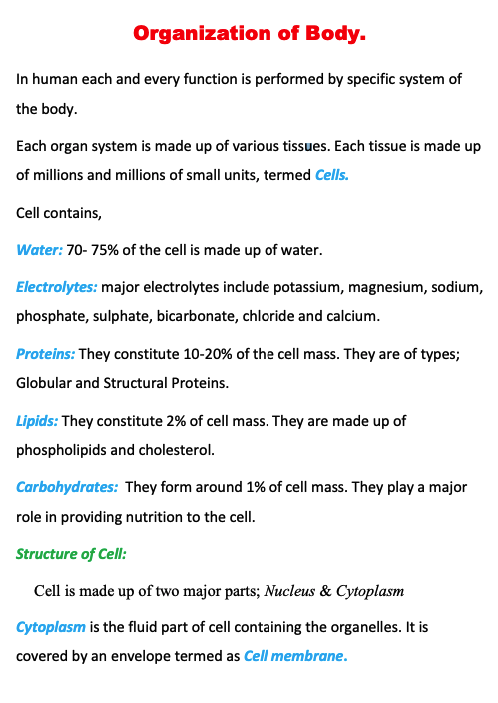Organization of the Body
Summary:
This text discusses the organization of the human body and provides information about cells, the structure of cells, cell division, and different types of tissues. It explains that each function in the body is performed by specific systems, composed of various tissues, and each tissue comprises cells. The main components of a cell, such as water, electrolytes, proteins, lipids, and carbohydrates, are described. The text also explains the structure and functions of the cell membrane, nucleus, and cytoplasm. Additionally, it discusses the four main types of tissues: epithelial tissue, connective tissue, muscle tissue, and nervous tissue, and provides details about each type. The text also mentions the types of cartilage and bone tissue.
Excerpt:
Organization of the Body
In humans, each and every function is performed by a specific system of the body.
Each organ system is made up of various tissues. Each tissue is made up of millions and millions of small units, termed Cells.
Cell contains:
– Water: 70- 75% of the cell is water.
– Electrolytes: Major electrolytes include potassium, magnesium, sodium, phosphate, sulphate, bicarbonate, chloride and calcium.
– Proteins: They constitute 10-20% of the cell mass. They are of types; Globular and Structural Proteins.
– Lipids: They constitute 2% of cell mass. They are made up of phospholipids and cholesterol.
– Carbohydrates: They form around 1% of cell mass. They play a major role in providing nutrition to the cell.
Structure of Cell:
The cell is made up of two major parts; Nucleus & Cytoplasm
Cytoplasm is the fluid part of the cell containing the organelles. It is covered by an envelope termed a Cell membrane.
Cell membrane: It is the membrane surrounding the cell. It covers the nucleus and the cytoplasm. It is a semi-permeable membrane. It is 7-10 mm thick. The membrane is made up of proteins, lipids, and a little of
carbohydrates. It is made up of two layers of phospholipids.


Reviews